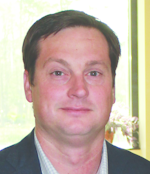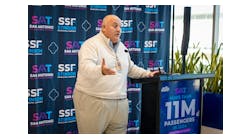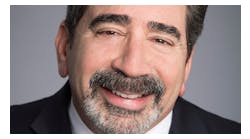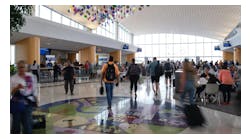Chicago’s O’Hare Airport has nearly 5 million square feet of space that must be cleaned every day throughout the year. In 2012, airport administrators signed a contract with a local cleaning contractor who agreed to clean the facility for $99 million annually. The contract was set to run for five years and ends at the end of this year.
However, the contractor said there were unanticipated cost overruns. So in 2014, he billed O’Hare an extra $5.2 million; in 2015 the cleaning company added another $1.7 million; and last year they tacked on another $750,000. At the end of the day, the $99 million contract ballooned to more than $107 million annually.
Since then, there have been a number of lawsuits and accusations going back and forth between the city and the contractor as well as the union representing the cleaning workers and the contractor. And while the cleaning contractor said the increased charges were mainly the result of wage issues and due to increased costs for cleaning products and materials, it is possible the airport itself must share some of the blame – if the request for proposal (RFP) they were working with was not up to date.
RFPs and the Evolution of Cleaning
There are all types of requests for proposals; some are for copiers, telephone systems, as well as cleaning. Essentially a request for proposal is a document that solicits proposals asking dealers and service providers what products or services they will provide – per the RFP - and how much money this will cost. However, an RFP for cleaning is different.
For instance, if airport administrators have not purchased a new copy machines in the past several years, the first thing they want to know is what innovations and technologies are now available for copy machines. Administrators just know that this is a high-tech industry and that changes and updates are being introduced all the time. Same goes for phones, computers, even sensor controlled restroom fixtures.
However, many administrators do not view professional cleaning as an evolving industry with new advances, innovations, or technologies. And in all fairness, administrators overseeing cleaning operations and the hiring of cleaning contractors twenty to thirty years ago, likely saw few changes in cleaning techniques and equipment.*
That all began to change in the late 1990s. This primarily was a result of the introduction of green or environmentally preferable cleaning products and equipment. While this initially involved just cleaning chemicals (solutions), in time the green evolution also impacted and changed how vacuum cleaners were manufactured, floor machines, carpet cleaning equipment, and cleaning tools. And eventually, the traditional methods used to clean facilities were replaced due to green cleaning along with the goals of improving worker productivity, addressing ergonomic issues, and promoting safety.
In other words, in the past ten to fifteen years, just about everything in cleaning has changed and many building administrators not only in airports but, in schools, office buildings, convention centers, etc., simply have not been aware of this. As a result, they often just re-submit an outdated RFP that does not address the evolution in cleaning and which may be costing them money because of new cleaning systems and technologies.
But before we update our RFPs, we need to take a close look at our SOW, otherwise known as the scope of services.
Understanding the SOW
The SOW serves as the foundation for an RFP. While there may be different definitions, for our purposes here, and as it applies to cleaning, we can define a SOW as:
- A formal document, meaning that it is in writing
- The document outlines all of the cleaning needs of the entire airport with all areas of the airport identified as if on a map
- How often areas are to be cleaned, referred to as “cleaning frequencies;” for example some areas must be cleaned multiple times per day, once per week, etc. Often this is based on how much use or foot traffic an area receives.
- When areas can be detail-cleaned; if Gate C shuts down around 6 pm, but Gate E is busy till midnight; obviously Gate C should be detailed first
- Types of cleaning equipment to be used; for instance, ride on floor cleaning equipment, burnishers, low-speed, etc.
- If a green cleaning strategy is in place (this could also involve sustainability issues)
- Where cleaning products are to be stored; how cleaning solutions are to be mixed (diluted), manually or using an auto-diluting system
- Noting areas in the airport most impacted by adverse outdoor weather; these areas will have specific cleaning needs (this would also include preventive cleaning measures, which are ways to keep such areas clean during such weather conditions)
- Cleaning evaluations and how they will be carried out.
Before moving on, we have a couple of things to address.
First regards the cleaning evaluation process. Airport administrators need to know that especially in restrooms, personal observation or subjective reviews of cleaning are out the door. We need much more scientific testing protocols. One option is the use of ATP monitoring systems. Inexpensive and available from a janitorial distributor, these systems do not identify pathogens, for instance on a restroom counter or floor. Instead, a high ATP rating would indicate that harmful pathogens may be on that surface, suggesting this surface be cleaned again, more thoroughly, or using a different cleaning solution or method. (See sidebar: What is ATP?)
And second, preparing a SOW can be complicated. Calling in an astute janitorial distributor can prove very beneficial. Not only will he or she be up-to-speed on the latest cleaning products and methodologies, but some will also be able to help administrators select cleaning solutions and other products that are for instance, more cost effective, green, etc. More on this later.
How the SOW Changes the RFP
To understand how the SOW impacts the RFP, let’s use the following scenario based on O’Hare once again. Please note, this is just a scenario, and it could apply to any airport.
Let’s suppose that O’Hare’s RFP is several years old and requires that all hard surface floors be stripped and refinished three times per year. However, our janitorial distributor helping us prepare the SOW indicates that there are floor finishes available today that, with proper maintenance procedures in place, can reduce floor refinishing cycles to every twelve months.
So let’s say our cleaning contractor bidding on the O’Hare contract estimated it would cost $6 million annually just to strip and refinish floors. But due to the distributor's suggestions, which are now part of our SOW and reflected in the RFP, floor refinishing is just required once per year. This could save the airport several million dollars annually.
Again, while this is just a scenario, it gives us an idea of the type of cost savings an airport can realize with an updated SOW and RFP. There are many other possibilities as well.
The Janitorial Distributor
Just as administrators turn to their suppliers of copy machines to find out what new technologies have been introduced, it’s time for airport administrators to work with janitorial distributors to see what new cleaning products and technologies have been introduced that can reduce costs, promote safety, protect the indoor environment, etc. And because there are now literally thousands of cleaning solutions and products available – something that was not the case not too long ago - some distributors now work with web-based dashboard systems. These systems help identify the specific cleaning needs of each section of the airport as well as the types of cleaning products that are best suited to maintain those areas.
We should note that at least one of these dashboard systems is free for administrators to use on their own. However, because an airport is used by thousands of people every day, it would be best to work with a “person” along with the web technology. There is simply too much involved and no room for trial-and-error decisions.
Michael Wilson is vice president of Marketing for AFFLINK, a global leader in supply chain optimization, providing clients with an innovative process such as the ELEVATE process as well as procurement solutions to drive efficiencies in today’s leading businesses. He can be reached thru his company website at www.AFFLINK.com
*There were of course some exceptions. In the mid-1950s, the first automatic floor scrubbing machines were introduced; in the mid- to late-1970s, carpet extractors for cleaning carpets came to market.





